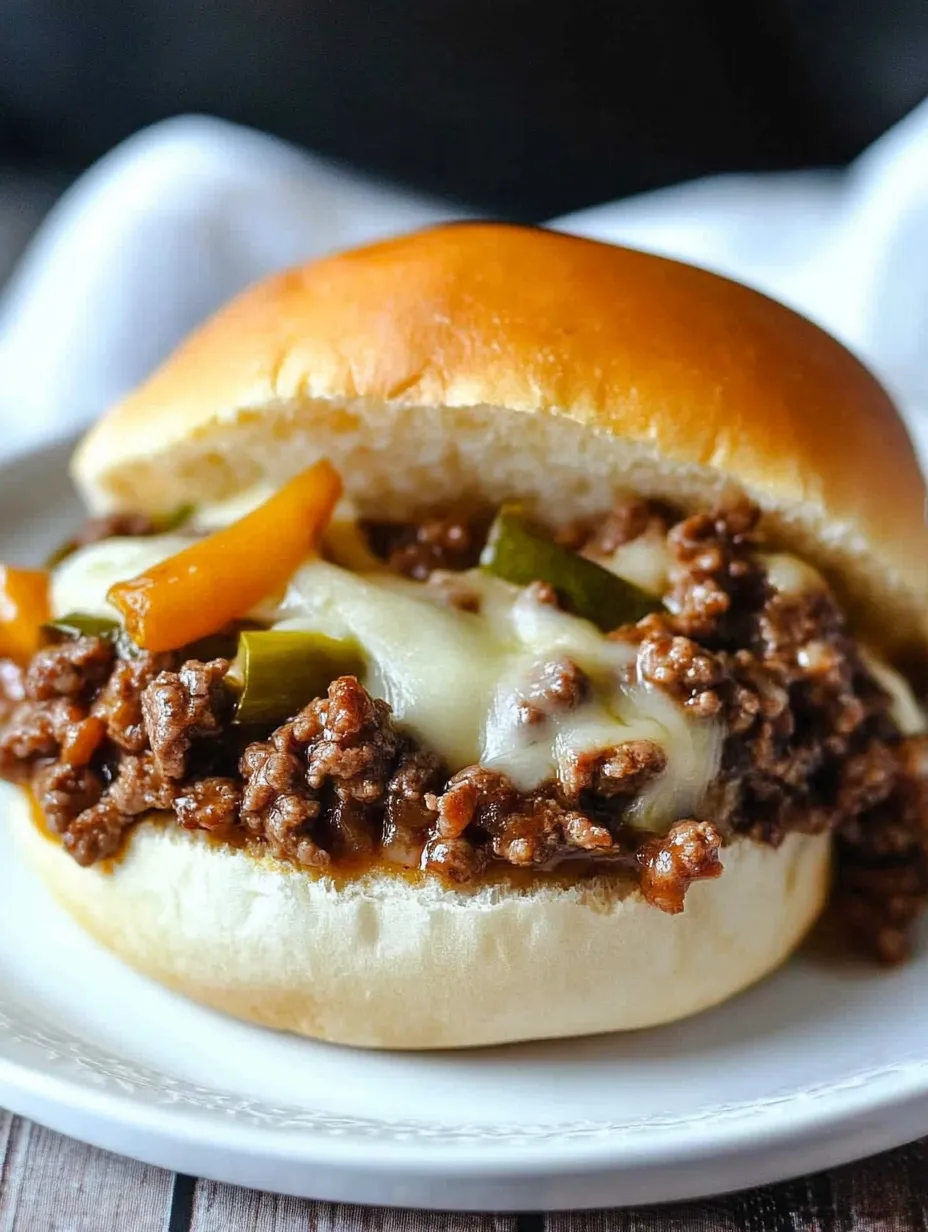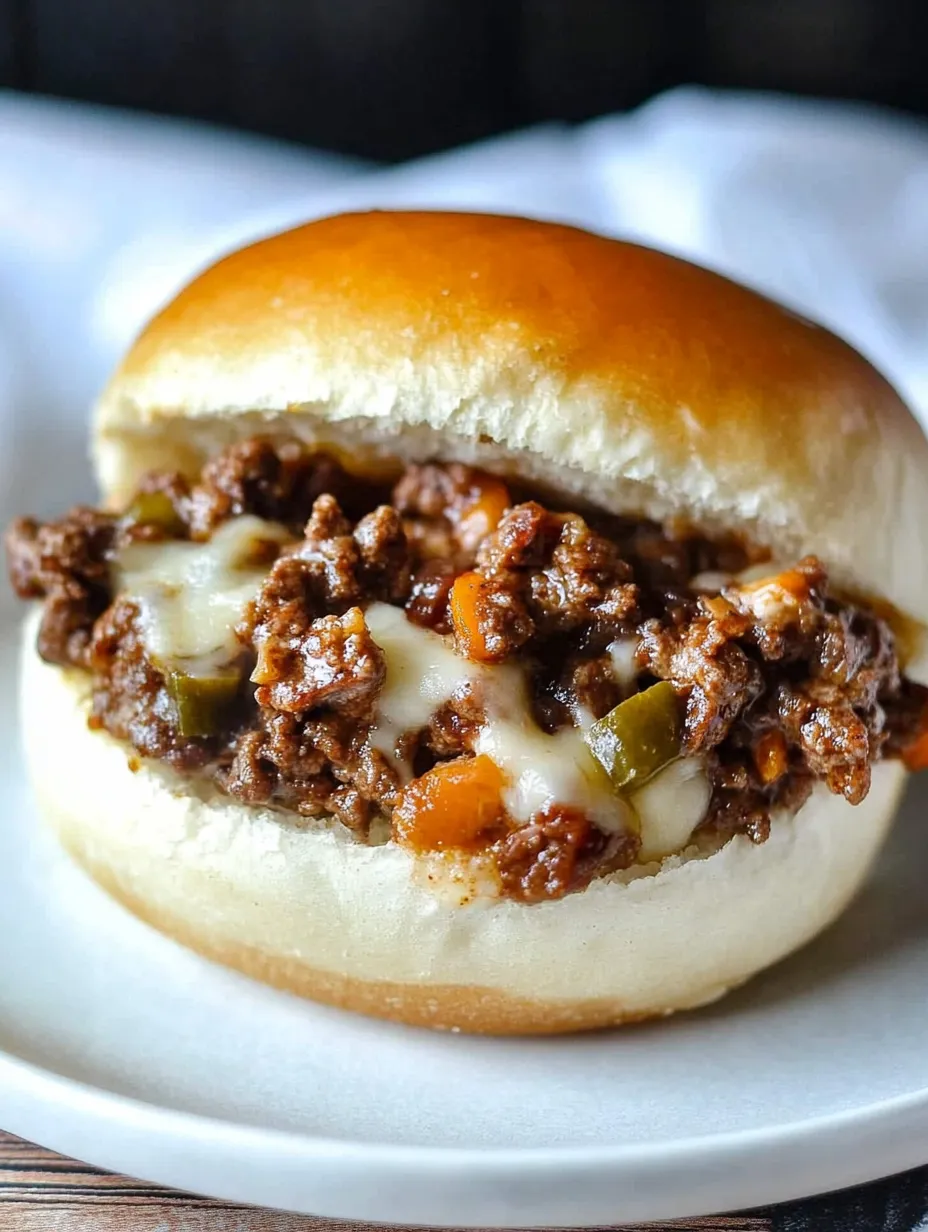 Pin it
Pin it
Classic Philly cheesesteak flavors merge with nostalgic sloppy joe comfort in this ingenious crossover that delivers the best elements of both beloved sandwiches. This clever combination transforms traditional ground beef into something extraordinary through careful cooking techniques and strategic ingredient additions. The caramelized beef and vegetables swimming in savory sauce with melted cheese creates an irresistible filling that threatens to overwhelm your bun in the most delicious way possible. Perfect for casual entertaining or weeknight family dinners, this recipe bridges sophisticated flavor with approachable preparation.
Craveworthy Elements
Last month when I served these at my son's basketball team gathering, several parents discreetly asked for the recipe before leaving. Even my neighbor who typically avoids "messy foods" somehow managed to devour an entire sandwich without a single napkin. The universal appeal spans both sophisticated palates and those who simply appreciate delicious food.
Quality Components
- Lean ground beef: This protein base provides rich meaty flavor while releasing minimal grease. Select 85-90% lean beef that offers the perfect balance of flavor from fat content while preventing excessive greasiness that would make the sandwiches unpleasantly soggy.
- Bell peppers and onions: These aromatic vegetables contribute essential Philly cheesesteak character. Their natural sweetness develops during cooking, creating flavor complexity while adding texture and color throughout the mixture.
- Mushrooms: These fungi add umami depth and substantial texture. Their natural moisture releases during cooking, contributing to the sauce while their meaty quality enhances the overall satisfaction of each bite.
- Provolone cheese: This semi soft cheese provides the signature tangy creaminess. Its excellent melting properties allow it to incorporate perfectly throughout the mixture rather than separating or becoming stringy.
- Brioche buns: These slightly sweet, buttery vessels perfectly complement the savory filling. Their sturdy structure holds up to the substantial moisture without disintegrating while providing textural contrast to the soft filling.
 Pin it
Pin it
Cooking Method
- Develop Beef Flavor Foundation
- Begin by heating a large cast iron skillet or heavy bottomed pan over medium high heat until properly hot. Add ground beef to the dry, preheated surface without stirring immediately. This patience allows a deep brown crust to form on the bottom layer, creating concentrated flavor compounds through the Maillard reaction. After significant browning develops, break apart the meat and continue cooking until all pieces show proper caramelization rather than merely turning gray.
- Create Vegetable Complexity
- Remove browned beef to a plate while retaining flavorful rendered fat in the pan. Add butter to enhance richness, then introduce diced onions, bell peppers, and mushrooms to the hot surface. Allow vegetables to cook undisturbed for 1-2 minutes before stirring, creating caramelized edges that develop sweet notes to balance the savory meat. Continue cooking until vegetables soften while maintaining some textural integrity rather than becoming mushy.
- Combine Primary Elements
- Return the caramelized beef to the skillet with the vegetables, combining thoroughly to integrate flavors. This reunion allows the beef to absorb the aromatic compounds released from the vegetables while the vegetables coat with the savory beef fat, creating cohesive flavor throughout the mixture rather than separate components sharing space.
- Build Sauce Complexity
- Create a slurry by whisking cornstarch into beef broth until completely dissolved, ensuring smooth thickening without lumps. Add ketchup and Worcestershire sauce to the meat mixture, stirring to coat evenly with these tangy, savory ingredients. Pour the cornstarch slurry over everything, stirring constantly as the mixture comes to a gentle simmer. This controlled thickening creates the perfect consistency that clings to meat and vegetables rather than pooling separately.
- Incorporate Cheese Element
- Remove the skillet from heat once the sauce reaches proper consistency, where approximately three quarters of the mixture stands above the liquid line. Add chopped provolone cheese while the mixture remains hot, stirring gently as residual heat melts the cheese throughout the filling. This method creates creamy pockets of cheese throughout rather than a solid cheese layer that would separate from the meat during eating.
- Prepare Proper Vessels
- While the filling completes its final stages, prepare brioche buns by splitting and lightly buttering cut sides. Place under broiler or in toaster oven until golden brown, creating a protective barrier that prevents immediate sogginess when filling is added while enhancing flavor through the toasting process. The contrast between crisp toasted bun and soft filling creates textural interest in each bite.
- Assemble With Strategy
- Place toasted bun bottoms on serving plates and promptly top with generous portions of the hot filling, allowing it to mound slightly above the edges. Cap immediately with toasted top buns, pressing gently to secure components without flattening completely. This proper assembly timing ensures sandwiches retain their integrity through serving and initial bites.
My grandfather, a Philadelphia native, always insisted that the secret to any great Philly inspired dish was developing proper caramelization on both meat and vegetables. I discovered through experimentation that allowing the ground beef to form a deep brown crust before breaking it apart creates remarkably more flavor than constantly stirring from the beginning. This simple technique transformed this dish from good to memorably delicious.
Serving Suggestions
Elevate this casual meal with thoughtful accompaniments that complement rather than compete. Create a complete pub style experience by serving alongside crispy oven baked french fries dusted with garlic salt for savory continuity. For textural contrast, offer dill pickle spears whose acidity cuts through the richness of the cheese and meat filling. When entertaining, consider setting up a topping bar with options like pickled hot peppers, crispy fried onions, and additional cheese varieties that guests can add according to preference. For a balanced family meal, include a simple side salad with vinaigrette dressing that provides fresh counterpoint to the hearty sandwiches.
Creative Variations
This versatile base recipe welcomes thoughtful modifications to create new experiences. Develop a southwest version by incorporating taco seasoning into the meat and substituting pepper jack for provolone. Create an Italian inspired variation by adding Italian herbs, substituting marinara for ketchup, and using mozzarella cheese. Transform into an open faced version by serving on thick Texas toast with additional melted cheese broiled on top for impressive presentation. For lower carb needs, serve the filling in lettuce cups or over roasted vegetables instead of buns. Create breakfast inspired variation by topping with a fried egg whose runny yolk creates another dimension of richness.
 Pin it
Pin it
Storage Strategy
Preserve the excellence of this dish beyond the initial serving through proper storage techniques. For immediate leftovers, store the filling separate from buns in airtight containers in the refrigerator for up to three days, where flavors continue melding for arguably better taste upon reheating. When preparing for future meals, cool filling completely before transferring to freezer safe containers, where it maintains quality for up to two months. Thaw overnight in refrigerator before reheating gently in a skillet with a splash of beef broth to restore moisture. For meal prep convenience, prepare a double batch of filling, portioning into individual servings that can be frozen, then quickly reheated and assembled on fresh buns for minimal weeknight effort with maximum flavor returns.
I discovered this recipe during a summer when my children constantly requested both Philly cheesesteaks and sloppy joes in the same week. What began as a practical solution to please everyone simultaneously has become one of our family's most requested meals. The combination of familiar comfort food formats with more sophisticated flavor profiles creates something that satisfies both simple preferences and more developed palates at the same table.
Frequently Asked Questions
- → Can I make this recipe ahead of time?
- Yes! The meat mixture can be made up to 2 days ahead and stored in the refrigerator. When ready to serve, reheat it gently on the stove, add the cheese, and spoon onto freshly toasted buns for best results.
- → What can I substitute for provolone cheese?
- White American cheese or mozzarella work great as substitutes, giving you that melty texture. Swiss cheese also pairs well with the beef. For a more authentic Philly cheesesteak flavor, you could even use Cheez Whiz.
- → How can I make this healthier?
- Use extra lean ground beef or substitute ground turkey or chicken. Serve on whole grain buns instead of brioche, or in lettuce cups for a low-carb option. You can also add more vegetables like zucchini or carrots to the mix.
- → Can I freeze the meat mixture?
- Absolutely! The meat mixture freezes well for up to 3 months. Thaw overnight in the refrigerator and reheat in a skillet. Add the cheese after reheating and just before serving for the best texture.
- → What sides go well with these sloppy joes?
- Classic pairings include french fries, onion rings, or potato chips. For a healthier option, try a side salad, steamed vegetables, or coleslaw. Pickles or pepperoncini on the side add a nice tangy contrast to the rich sandwiches.
